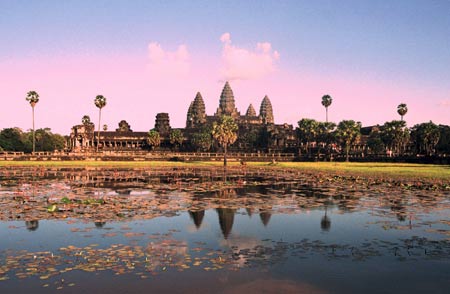 |
1.小吳哥城(Angkor Wat) 高棉最雄偉壯觀的都城,名列世界七大奇景的吳哥窟,指的正是這座寺廟。這座中心塔高約65公尺(相當於20層樓高),是山形廟的最高峰。城內精雕細琢磚磚瓦瓦,一磚一故事,一瓦一神話,是高棉吳哥王朝全盛時期所遺留下來的不朽宗教建築;全城雕刻之精美有「雕刻出來的王城」美譽。此為高棉有史以來最宏偉的都城,也是200多座古蹟中唯一正門向西的神廟,小吳哥的主殿四周,共有八處巨幅石雕,每幅都長達 120 公尺,分別敘述印度教的神話故事,這些故事都和戰爭與國王的功跡有關。主殿內有一座高塔,建在三層台上,塔下方圍繞著廣場,據說這是「海洋包圍高塔」的意念設計。廣場四角的仙女浮雕和高塔內的神話雕刻,刻繪細致,藝術價值極高,許多藝術家的作品,都是從這些石雕像中獲取靈感。吳哥窟,不只是座榮耀神祇的廟宇,也是人間對天堂的極致想像與體現。 |
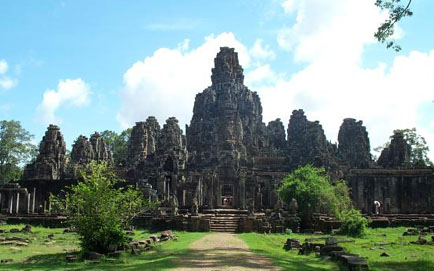 |
2.大吳哥城(Angkor Thom)大吳哥王城共有五個城門,每個城門的人口陸橋兩邊各有54尊阿修羅神和惡魔,分別抱著一條「七頭蛇」保護王城。在高約20公尺的城門頂端,是一尊巨大的四面佛。 大吳哥城(Angkor Thom)的意思是吳哥大城,東西長3公里,周圍面積12平方公里,是1181年中興吳哥王朝的君王蘇耶跋摩七世所建的新王郡,享有「雕刻出來的王城」美譽。 吳哥大城城牆全都由石頭砌成,長14公里據說此城可住百萬居民規模之大,超過羅馬古城。東西南北各有一城門及大道直通中心的巴戎寺,東門另多一個「勝利門」供送葬行列前往郊外火化死者, 五個城門長的都很相似,以南門保存及修護的狀況最為良好,其它幾道門的的雕像頭部幾乎被盜光。遊客探訪大吳哥城的第一站大部份都是以南門為主,高達七公尺的南門上頭,四面都刻著吳哥王朝全盛時期國王加亞巴爾曼七世的面容,此乃象徵眼觀四面耳聽八方的四面佛菩薩。 |
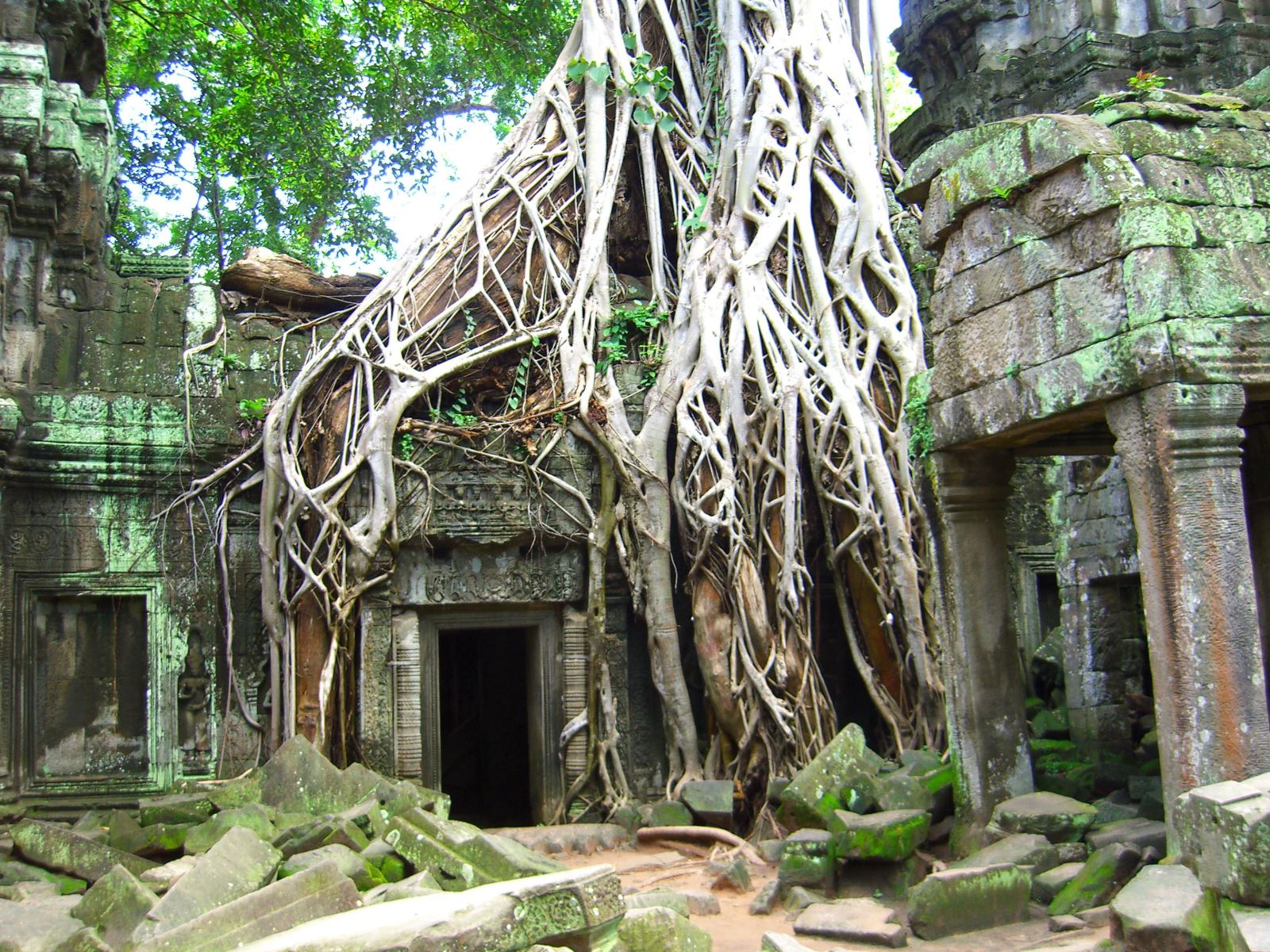 |
3.塔普倫寺廟(Taprohm) 塔普倫寺是古真臘吳哥王朝的國王加亞華爾曼七世衛他母親所修建的寺院。 塔普倫寺位於吳哥窟南部,尊奉婆羅門教和佛教,但現在崩落毀損的情狀相當嚴重,僅剩內層圍牆了。寺廟內的各種浮雕也極為精采,例如從東邊入口進門後,也有一座和寶劍塔類似的「Hall of Dancers」,其內成列的仙女雕像,個個都有飄逸浪漫的舞姿。而神殿內供奉的則是「智慧女神」,據說是加亞華曼七世依據母親的容貌所雕塑的。塔普倫寺還有一個極為特殊的建物叫「拍心塔」,如果站在塔裡背靠著牆然後拍打自己的胸,整個塔內就會發出宏亮的回音,有一說是講有良心的人,在裡面敲打胸膛就會發出回音,反之則無反應。 |
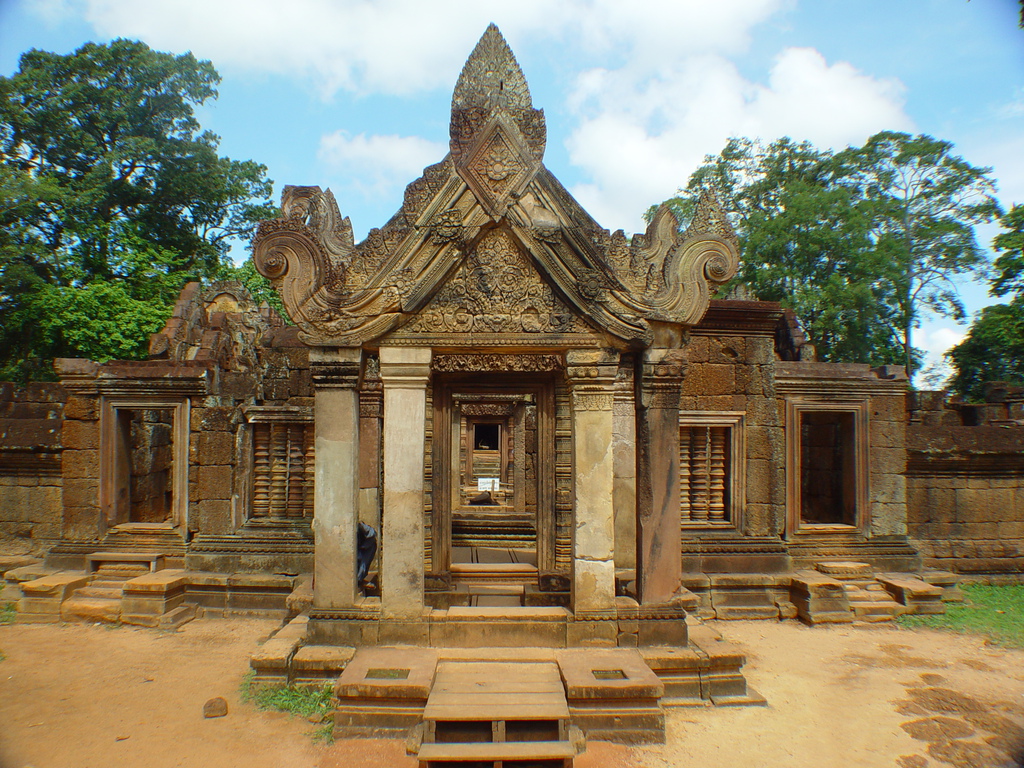 |
4.邦蒂斯蕾古神殿(Bantery Srei) 邦蒂斯蕾古神殿位於大吳哥東北面21公里,距離省會35公里的建於十世紀,公元967年時值加亞華羅曼五世王朝,此地為尊奉婆羅門教三大主神之一的—【濕婆神】。由於建造此座古剎的石頭為美麗的粉紅色,此廟壁畫的雕刻是所有吳哥古蹟中最精緻細美的,其中最令人讚賞的是創作者竟能將堅硬的石塊,如雕刻木頭般琢磨出層次分明線條柔纖的精細作品,不論門楣或石壁或窗櫺,都刻鏤的一絲不茍巧奪天工,妙不可言,是吳哥所有寺廟中石雕作品最上乘,也是柬埔寨藝術的顛峰之作,故又有「吳哥藝術之鑽(Jewelin Angkor Art) 的美譽 |
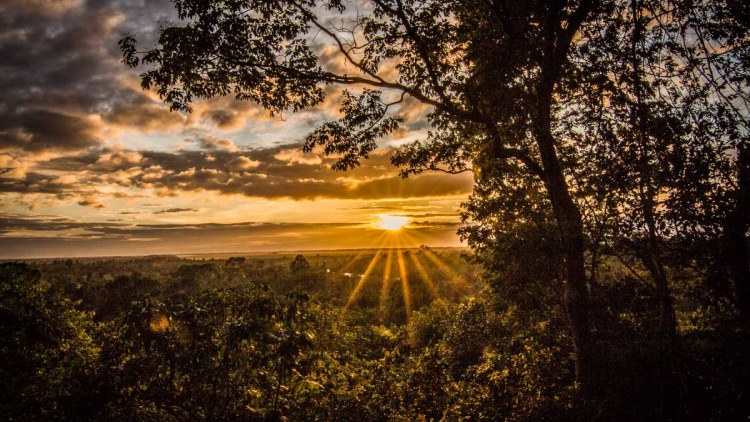 |
5.巴肯山 (PHNOM BAKHENG) 巴肯山,一座高度凌駕於所有吳哥古蹟的建築物。這邊是各國觀光客到吳哥地區最喜愛看夕陽的地方。每當夕陽西沉,在巴肯寺頂端的平台上總是湧進許多的觀光客,所以來這邊參觀,記得要五點左右就上山,避免遊客太多雍塞不通。巴肯寺是 9 世紀時吳哥王朝國王耶輸跋摩一世建都吳哥後第一座建立的祖宗宗廟。巴肯寺建立於吳哥窟西北 1.5 公里處的一座小山丘 (巴肯山),從巴肯山上可以俯瞰整個吳哥地區。巴肯山高約 67 公尺。 巴肯寺的結構是以印度教信仰之概念所建造而成的,象徵著須彌山。依照山勢的地形,一層層方正的平面空間及石牆砌造,向山頂上延伸並逐漸縮小,共有五級台基。最底層的面積 76 平方公尺,最上一層的面積是 47 平方公尺,就如同是「山」的形狀,越接近頂端,石階就越為陡峭。廟山頂部的五座寶塔,象徵須彌山的五座山峰。巴肯山腳下有四座紅磚建造的塔門,每層石階左右,守護著一對坐獅,有些石獅已破損。其中在東、北、西三面各有通道可供登上山頂,等於把整座巴肯山都規劃成一座寺廟。 |
1. Angkor Wat The most majestic capital of Khmer, Angkor Wat, one of the seven wonders of the world, refers to this temple. The central tower is about 65 meters high (equivalent to the height of a 20-story building), and is the highest peak of Yamagata Temple. The city is meticulously carved with bricks, tiles and tiles, each brick tells a story, and each tile tells a myth. It is an immortal religious building left over from the heyday of the Khmer Angkor Dynasty; . This is the most magnificent capital in Khmer history, and it is also the only temple with the main entrance facing west among more than 200 historic sites. Around the main hall of Little Angkor, there are eight huge stone sculptures, each of which is 120 meters long. Describes Hindu mythological stories, which are all related to wars and the deeds of kings. There is a tall tower in the main hall, which is built on a three-story platform, and the square is surrounded under the tower. It is said that this is the idea design of "the ocean surrounds the tower". The fairy reliefs at the four corners of the square and the mythological carvings in the tower are meticulously carved and of high artistic value. Many artists' works are inspired by these stone statues. Angkor Wat is not only a temple to honor gods, but also the ultimate imagination and embodiment of heaven in the world. |
2. Angkor Thom (Angkor Thom) There are five city gates in the Great Angkor Thom. There are 54 gods of Asura and demons on both sides of the entrance bridge of each gate, holding a "hydra" to protect the city. At the top of the city gate about 20 meters high is a huge four-faced Buddha. Angkor Thom (Angkor Thom) means the big city of Angkor. It is 3 kilometers long from east to west and has a surrounding area of 12 square kilometers. The "King City" reputation. The walls of the great city of Angkor are all made of stone and are 14 kilometers long. It is said that the city can accommodate a million residents, which is larger than the ancient city of Rome. There are city gates and avenues leading directly to the central Bayon Temple in the east, west, south, north, and another "Victory Gate" in the east gate for the funeral procession to go to the suburbs to cremate the dead. The five city gates are very similar in length, and the south gate is in the best state of preservation and repair. Almost all the heads of the statues of the other gates have been stolen. Most of the first stop for tourists to visit Angkor Thom is the south gate. On the top of the seven-meter-high south gate, the face of Gayabalman VII, the king of the heyday of the Angkor Dynasty, is engraved on all sides. It symbolizes the four-faced Buddha Bodhisattva who sees all directions and hears all directions. |
3. Ta Prohm Temple (Taprohm) The Ta Prohm Temple is a temple built by the mother of the king of the Angkor Dynasty in ancient Chenla, Gayawarman VII. Ta Prohm Temple is located in the south of Angkor Wat, and it worships Brahmanism and Buddhism, but now it has collapsed and damaged quite seriously, and only the inner wall remains. The various reliefs in the temple are also very splendid. For example, after entering the door from the east entrance, there is also a "Hall of Dancers" similar to the Sword Tower. There are rows of fairy statues in it, all of which have elegant and romantic dancing postures. The "Goddess of Wisdom" is enshrined in the temple, which is said to have been sculpted by King Jayahuaman VII according to his mother's appearance. There is also a very special building in the Ta Prohm Temple called "Pai Xin Pagoda". If you stand in the pagoda with your back against the wall and pat your chest, there will be a loud echo in the entire pagoda. There is a saying that there is a conscience. If someone beats his chest inside, there will be an echo, otherwise there will be no response. |
4. Bantery Srei Located 21 kilometers northeast of Angkor and 35 kilometers from the provincial capital, the Bangtisley Temple was built in the tenth century. It was in the reign of Gayahua Roman V in 967 AD. It is one of the three main gods of Brahmanism. -【Lord Shiva】. Due to the beautiful pink color of the stone used to build this ancient temple, the carvings on the murals of this temple are the most exquisite and detailed among all the Angkor monuments. It is the best stone carving work in all the temples of Angkor, and it is also the pinnacle of Cambodian art. Therefore, it has the reputation of "Jewelin Angkor Art" |
5. PHNOM BAKHENG Bakken Hill, a building higher than all Angkor monuments. This is the favorite place for tourists from all over the world to watch the sunset in the Angkor area. Whenever the sun sets, there are always a lot of tourists on the platform at the top of the Bakken Temple, so when you come here to visit, remember to go up the mountain around five o'clock to avoid too many tourists. Bakken Temple is the first ancestral temple built after King Yasuvarman I of the Angkor Dynasty established his capital in Angkor in the 9th century. Bakken Temple was built on a small hill (Bakken Hill) 1.5 kilometers northwest of Angkor Wat. From Bakken Hill, you can overlook the entire Angkor area. Mount Bakken is about 67 meters high. The structure of Bakken Temple is built according to the concept of Hindu belief, which symbolizes Mount Sumeru. According to the topography of the mountain, layers of square plane spaces and stone walls are built, extending to the top of the mountain and gradually shrinking, with a total of five levels of platform. The area of the bottom floor is 76 square meters, and the area of the top floor is 47 square meters. It is like a "mountain" shape. The closer to the top, the steeper the stone steps. The five pagodas on the top of the temple mountain symbolize the five peaks of Mount Sumeru. At the foot of Bakken Mountain, there are four tower gates made of red bricks. Around each stone step, a pair of sitting lions are guarded, and some of the stone lions have been damaged. Among them, there are passages on the east, north, and west sides for climbing to the top of the mountain, which is equivalent to planning the entire Bakken Mountain into a temple. |
TOP |

 .......热点省份代理人 詹经理 Rock Chan
.......热点省份代理人 詹经理 Rock Chan